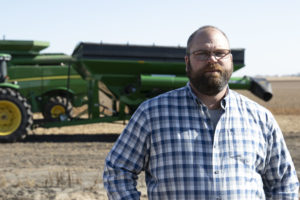
Partnerships That Drive Success
Guests: Todd Arduser, Kevin Poppel
In this episode of Channel Chat, farmer Kevin Poppel talks about the relationships and advice that have helped him find success in farming.
Listen to Episode
 Ag Over Easy Podcast
Ag Over Easy Podcast
The much anticipated USDA Annual Acreage Report has been released, and grain marketing expert Matt Bennett weighs in on the results. Tune in to find out what the June 2019 report means for farmers and the rest of their season in this bonus episode of Channel Chat.


Matt Bennett is not only one of the industry's most respected grain marketing consultants but he's also a farmer himself. With a 3,000-acre corn and soybean farm, Matt understands firsthand the challenges and risks involved in being a farmer. Matt takes his decades of successful experiences, on and off the farm, to provide you with his time-proven approach to grain marketing.
Amity Shedd:
Hi there. Thanks for joining us for this bonus episode of Channel Chat. I'm Amity Shedd, and today we have grain marketing expert Matt Bennett on the line. He's going to help us digest and go through some of the highlights of the USDA annual acreage report that was released earlier today on Friday, June 28th.
Matt, I know a lot went on with the report this morning. I was checking out some articles online and saw words like explosive being used. I think it's safe to say a lot of people in the agriculture field are a little shocked and surprised at the USDA acreage report released. So what's your initial reaction to what you saw this morning?
Matt Bennett:
You know, initially I was watching the screen for prices, and the very first kick for corn was up 14 cents whenever the report was released. And in a matter of 30 seconds to a minute, the corn market had gone from up 14 to down 12, to up 12 to down a nickel. And that is extremely unprecedented, a volatile situation. And the reason for that is that there was a lot of computers, the computer models trade this market so heavily. It's very high tech compared to what it was, you know, even whenever I was a kid growing up.
And so the volatility is pretty wild whenever you get an interesting set of numbers. Essentially, the trade was expecting corn acreage to be below the June estimate that the USDA came out with earlier this month, which was 89.8 million acres.
Now the March planting intentions number, which is what producers intended to plant as of March 1, was 92.8. So the USDA originally saw here in the month of June that we would be going down about 3 million acres. But this report is actually survey-based. So they go to producers as of June 1 and they say, “How many acres either have you planted or are you still intending to plant?” And then of course as of June 1, most producers were probably not intending on prevent plant if they could avoid it. They still wanted to plant corn.
And so we came out with 91.7, which is a little bit mind-boggling considering that just a couple of weeks ago the USDA told us 89.8. Now this is survey-based, so there's not any objectivity there. It's simply based upon the information they gathered. As far as soybean acreage is concerned, earlier they came out with 84.8. This report said 80 million acres, so significantly below their June number first of all. Second of all, significantly below any trade or estimate.
And so I know that there were a lot of people who were surmising this might be a little bit of a drop in bean acreage, just simply due to the fact that this weather this year has been such a challenge. But as far as dropping 80 million acres, that was certainly a shock. Now I will caution people who think that the final acreage number might be 80 million on soybeans. There's been a significant number of soybeans planted late in the month of June. They're getting planted today. They will get planted into July, especially in the areas where, for instance, you have wheat planted and then double crop soybeans.
We've seen those producers in the last three years have extremely good bean yield, even planted into the first of July, maybe up to the 10th of July. So we expect, I expect, bean acreage is going to grow. And then today's number on corn acreage is almost certain to come down a fair amount in that we did not have any prevent-plant acres essentially rolled up into this number.
So most likely, your average trader guess right now is between 5 and 8 million acres of prevent-plant acres. Corn acreage is likely to go down, I would say at least five million acres first of all. And then second of all, whenever you have a really wet year, typically the harvested percentage of acreage as compared to the planted acreage ends up being a lower percentage. So I still think there's a lot yet to be known.
We really won't get a good idea on prevent-plant acres until we get into the month of August whenever a lot of the FSA data starts to show up, and at that point we can start to unfold this just a little bit. But for the time being, there are still a lot of question marks.
Amity Shedd:
So in general speaking terms, corn and soybeans basically flip-flopped expectations. How does that affect stock numbers?
Matt Bennett:
The quarterly stocks numbers were released today, which the interesting thing was both corn and beans ... and I know we're not going to spend any time talking about wheat. But all three — corn, beans and wheat — came in below the expectations of the trade, which is certainly friendly, which means that we've got less of these on hand as of June 1. And so with corn, it was more than a 100 million bushels fewer.
That is actually a number you can put your finger on. It tells you that our carryout going into this next marketing year is going to be lower than what we thought, at least by a 100 million bushels. It was a very friendly number. With that being said, the trade chose to focus more on acreage than it did on the stocks numbers. And thus, we ended up with a corn market that was down 19 to 20 cents on the day, which is the biggest move we've seen in some time.
Conversely, with soybeans, not only did you get our friendly acreage number but you had friendly stocks number as well. And so we find out that the bean stocks are actually lower than what we thought. Now, corn and bean stocks being lower than what we thought would make sense to me, personally. Whenever I look around ... yes, we know we've had weather issues, but whenever you look at the basis levels throughout the country, most processors have increased basis levels, or in essence they've ... they say in the industry they've narrowed them so that the price relative to the board of trade has gotten better.
Whenever the basis levels improve, typically what that means is that the processors are worried about being able to get those commodities purchased. And so basis levels have actually been really good, which tells me this shouldn't be a huge surprise to anybody that we have less stocks on hand than what we thought coming into this report.
Amity Shedd:
OK. And how might this report change the mindset of producers and farmers? Their marketing plan for the rest of the year?
Matt Bennett:
Originally, initially if you will, most producers probably had a lot of choice words to say when they saw that 91.7 million acres. It's kind of a kick in the teeth. It's not been a great year. Quite frankly, this has been extremely stressful. Coming out of the winter time frame, let's face it, you know, profitability and profit margins were forecasted to be abysmal in 2019. Now fortunately, even though the weather has been horrific, we've had a nice rally in the corn market, a nice rally in the bean market. That's certainly helped to get producers’ moods a little more upbeat than what they were.
But again, initially I would say that it certainly was nothing to get happy about in any stretch of the imagination. Most producers are not going to get terribly excited about the fact that beans went up a dime whenever corn is down 20 cents. But well, how does it affect us moving forward? I think we have to take these numbers with a grain of salt. We really don't know exactly what any of these acreage numbers mean yet. I think that we have to give this some time and let it play out. If I'm a producer who doesn't have a whole lot of corn marketed and I don't really know what my crop's going to be ... similar to a lot of producers in the country who have corn that's not even the high by the 4th of July this year, I don't want to get too aggressive. And I don't want to get too down in the dumps and feel forced into make a marketing decision just yet, especially if I don't feel like it can be profitable.
And quite frankly, with most producers’ yield projections, even though it's a late crop, we know these hybrids are phenomenal nowadays. But the unfortunate thing is that the hybrid can only do so much whenever you have extreme conditions like we've had this spring. And so, I want to be very cautious as to assume that my yield will be anything like it's been the last few years. Plug in a reasonable yield given the weather that we've seen and the cost structure that I have, figure out what that break-even level is, and then if we still think we can make money at these prices, by all means we should step forward and continue with our marketing plan. But I certainly don't want to be making sales just basically out of fear.
Amity Shedd:
Right, right. Can you touch a little bit on some price objectives? What levels do you think farmers should be thinking about when they're making sales?
Matt Bennett:
Initially, the number one price we need to think about is, on our farm in particular ... whenever I say breakeven, a breakeven can include whatever salary you pay yourself. Or it should include all of your costs, whether it comes down to your land theme or whatever. But whenever you look at that breakeven and you know this is what you need to make this year work, if that breakeven is $4 a bushel and you can still get $4.20 a bushel at the elevator that you're hauling to, then that should be your price objective.
Now whenever I look at, you know, what are some of the technical points, originally we were hoping we could bust through $4.50 for December corn, and we did so. We went up, we didn't do anything that would make me believe that we set a high necessarily. Typically whenever you set a high, you make a new high and then you close that market lower on the day. We haven't seen anything like that yet. So that would lead me to believe that the highs aren't necessarily in.
So if I'm a producer trying to look for a price objective in general ... and again, I want to base it on my farm. But if I'm looking for something in general, it should be something north of $4.50. Now I feel confident that as the summer goes on, unless we just have absolutely pristine weather, that you will see price levels above $4.50 again.
Amity Shedd:
So Matt, what's the moral of the story? How do you wrap up today, this report, everything you got out of it, the highlights you went through? What's your bottom-line statement to people who are worried, people who are kind of shocked at what they saw, what's one thing that they need to keep in mind?
Matt Bennett:
Well, I know a lot of people are probably concerned that this is a game changer, and that may be the corn market might be over with. I would like to caution them into thinking that too much just yet. I don't want to base my marketing plan on any one day of marketing. I want to base my marketing plan on a long-term strategy, trying to maximize my return on investment on my farm. And so yes, today was, on Friday of the June report, not a wonderful day by any means for anybody who is bullish to market.
But in the grand scheme of things, how does this all fit in? What are we going to see as the year progresses? And so, we have to think about the things that we know. This crop went in the ground extremely late, we have not had a whole lot of heat until this past week. Most forecasters are calling for a fairly benign weather pattern and cooler-than-normal summer. If we have an early frost this fall or if this corn does not get the black layer similar to what we saw in 2009, then it's very likely that you'll see a significant amount of strength in the market.
I don't want to get too down in the dumps over just one report in one day of trading. So I think we got to keep our perspective. Whatever marketing plan that we've put together to date, we need to stick to that marketing plan and stay disciplined because whenever markets are this volatile, it's really hard to keep your discipline.
Amity Shedd:
Excellent. Excellent points, Matt. Thanks so much for joining us today on this episode of Channel Chat. Your expertise is so appreciated, especially on days like this when we get a report with not great news or what we were expecting. So thanks so much.
Matt Bennett:
Absolutely. I appreciate you having me on, and let's just hope that this next report goes a little better than today's did.

Guests: Todd Arduser, Kevin Poppel
In this episode of Channel Chat, farmer Kevin Poppel talks about the relationships and advice that have helped him find success in farming.
Listen to Episode

Guests: Colby Woods, Jessica Grubbs
As technology in agriculture continues to evolve, Channel Seedsman Colby Woods wanted to get ahead of the pack and offer drone scouting to his farmers in Eastern Nebraska. We caught up with Colby in Wahoo, Nebraska, along with Sentera Sales and Training Specialist Jessica Grubbs. Listen in this episode of Channel Chat.
Listen to Episode